|

The Equinox of Isadora Duncan
Photo essay by Dahna Barnett with introduction by Honora Foah
Balance: Having two legs is a risky choice. Four — sensible, functional, can be reduced to three and still work. Two — standing becomes a non-optimal state, so two legs are for movement. Human beings are meant for dynamic balance, not stability — movement, not stillness.
Great archs of motion and emotion were the hallmark of the style of balance created by dance pioneer Isadora Duncan. Poised here at the autumnal equinox, we celebrate the art and life of a woman whose love of Greek mythology led to her creation of a new artform of dance, centered, balanced around the solar plexus, using the rise and fall of the limbs and torso to express a flowing, musical line.
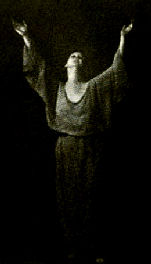 "The true dance is an expression of serenity; it is controlled by the profound rhythm of inner emotion.
Emotion does not reach the moment of frenzy out of a spurt of action; it broods first, it sleeps like the life in the seed, and it
unfolds with a gentle slowness." "The true dance is an expression of serenity; it is controlled by the profound rhythm of inner emotion.
Emotion does not reach the moment of frenzy out of a spurt of action; it broods first, it sleeps like the life in the seed, and it
unfolds with a gentle slowness."
— Isadora Duncan
"I do not know what the spirit of a philosopher could more wish to be than a good dancer. For the dance is his ideal, also his fine art, finally also the only kind of piety he knows, his 'divine service.'"
— Friedrich Nietzsche
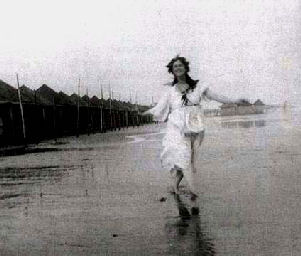
Isadora Duncan on the Lido in Venice
(Raymond Duncan, 1903)
"The movement of the waves, of winds, of the earth is ever in the same lasting harmony. We do not stand on the beach and inquire of the ocean what was its movement of the past and what will be its movement of the future. We realize that the movement peculiar to its nature is eternal to its nature.
The dancer of the future will be one whose body and soul have grown so harmoniously together that the natural language of that soul will have become the movement of the body."
— Isadora Duncan
"The dance of the future must become again a high religious art as it was with the Greeks. For art which is not religious is not art.
It is mere merchandise."
— Isadora Duncan
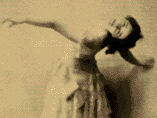
"I shall never forget the first time I saw her come on to an empty platform to dance. She came through some little curtains which
were not much taller than herself — she came through and walked down to where a musician, his back to us, was seated at a
large piano — he had just finished playing a short prelude by Chopin when in she came, and in some five or six steps was standing
at the piano, quite still — you might have counted five or eight, and then there sounded the voice of Chopin in a second prelude
or etude — it was played through gently and came to an end — she had not moved at all. Then one step back or sideways,
and the music began again as she went moving on before, or after it. Only just moving — not pirouetting or doing any of the
things which a Taglioni or a Fanny Elssler would have certainly done. She was speaking her own language, not echoing any ballet master,
and so she came to move as no one had ever seen anyone move before.
The dance ended, she again stood quite still. No bowing, no smiling — nothing at all. Then again the music is off, and she runs
from it — it runs after her — for she has gone ahead of it.
How is it that we know she is speaking her own language? We know it, for we see her head, her hands, gently active, as are her feet,
her whole person. And if she is speaking, what is it she is saying? No one would ever be able to report truly, yet no one present had a
moment's doubt. Only this can we say — that she was telling to the air the very things we long to hear; and now we heard them,
and this sent us all into an unusual state of joy, and I sat still and speechless."
— Gordon Craig
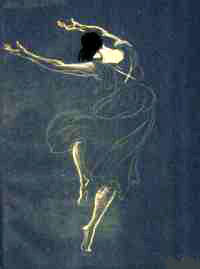
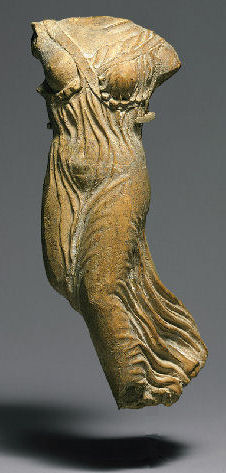
"The dancer of the future will be one whose body and soul have grown so harmoniously together that the natural language of that soul will
have become the movement of the body."
— Isadora Duncan
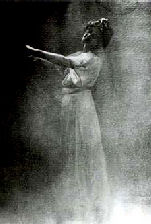
"The most astonishing thing was her stillness — she had this knack of holding a stillness and then moving at an exquisitely timed moment that made you crumble."
— Lynn Seymour, dancer in "Five Brahms Waltzes"
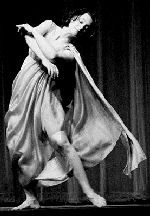
"The Dance —
it is the rhythm of all that dies in order to live again."
— Isadora Duncan
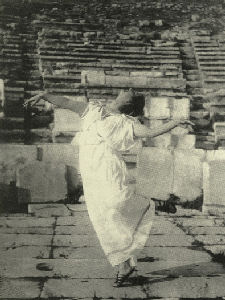
"The Greeks understood the continuing beauty
of a movement that mounted,
that spread, that ended with a promise of rebirth."
— Isadora Duncan
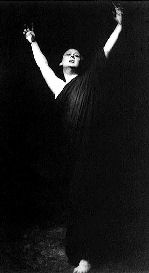
"If I could tell you what it meant,
there would be no point in dancing it."
— Isadora Duncan
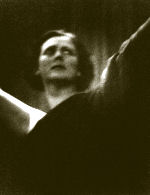 "Her life was indeed like a force of nature in its primitive energy and strength, like a flame, a wind, a tide flowing and
retreating across all the countries of the world. This daughter of the western ocean, whose first knowledge of the movements of the
dance came from the jig of an Irish grandmother who had crossed the plains in a prairie wagon, left everywhere behind her — in America,
in France, in Germany, in Russia, in Greece — images of Eternal Woman. Subjective yet universal images: the chaste and lovely
dancing maiden; the grande amoureuse, "Her life was indeed like a force of nature in its primitive energy and strength, like a flame, a wind, a tide flowing and
retreating across all the countries of the world. This daughter of the western ocean, whose first knowledge of the movements of the
dance came from the jig of an Irish grandmother who had crossed the plains in a prairie wagon, left everywhere behind her — in America,
in France, in Germany, in Russia, in Greece — images of Eternal Woman. Subjective yet universal images: the chaste and lovely
dancing maiden; the grande amoureuse,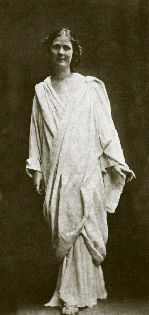 lover and beloved of all men; the maenad, hurling her knees upward to the tune of the world's
despair and revolution; the mother rejoicing and abundant, surrounded by joyous children; the mother sorrowing and bereft, smitten by a cruel
fate and driven ever after, bent in a veil of tears and lamentation. These are Isadora, legendary already as Sappho, or Helen of Troy, or Duse,
a creature who, for all her earthly passions, seems to live in a dream, to move to the most lyrical and stern rhythms of the world's great music,
to live in her own body... 'like a spirit in a cloud.'" lover and beloved of all men; the maenad, hurling her knees upward to the tune of the world's
despair and revolution; the mother rejoicing and abundant, surrounded by joyous children; the mother sorrowing and bereft, smitten by a cruel
fate and driven ever after, bent in a veil of tears and lamentation. These are Isadora, legendary already as Sappho, or Helen of Troy, or Duse,
a creature who, for all her earthly passions, seems to live in a dream, to move to the most lyrical and stern rhythms of the world's great music,
to live in her own body... 'like a spirit in a cloud.'"
— The New Republic
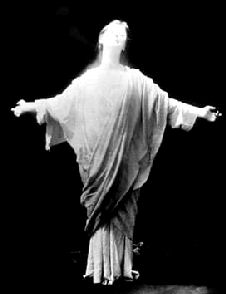
San Francisco Performing Arts Library and Museum
"The dancer's body is simply
the luminous manifestation of the soul."
— Isadora Duncan
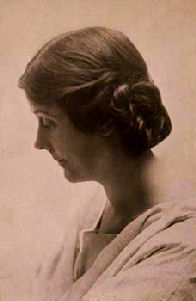
Isadora Duncan
May 27, 1878 - September 14, 1927
Learn more about Isadora Duncan at the
Isadora Duncan Dance Foundation website
Return to Mythic Passages Menu
Subscribe to the Mythic Passages e-magazine
|
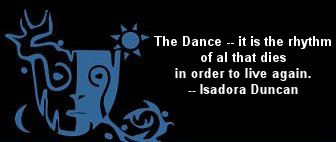

 "The true dance is an expression of serenity; it is controlled by the profound rhythm of inner emotion.
Emotion does not reach the moment of frenzy out of a spurt of action; it broods first, it sleeps like the life in the seed, and it
unfolds with a gentle slowness."
"The true dance is an expression of serenity; it is controlled by the profound rhythm of inner emotion.
Emotion does not reach the moment of frenzy out of a spurt of action; it broods first, it sleeps like the life in the seed, and it
unfolds with a gentle slowness."







 "Her life was indeed like a force of nature in its primitive energy and strength, like a flame, a wind, a tide flowing and
retreating across all the countries of the world. This daughter of the western ocean, whose first knowledge of the movements of the
dance came from the jig of an Irish grandmother who had crossed the plains in a prairie wagon, left everywhere behind her — in America,
in France, in Germany, in Russia, in Greece — images of Eternal Woman. Subjective yet universal images: the chaste and lovely
dancing maiden; the grande amoureuse,
"Her life was indeed like a force of nature in its primitive energy and strength, like a flame, a wind, a tide flowing and
retreating across all the countries of the world. This daughter of the western ocean, whose first knowledge of the movements of the
dance came from the jig of an Irish grandmother who had crossed the plains in a prairie wagon, left everywhere behind her — in America,
in France, in Germany, in Russia, in Greece — images of Eternal Woman. Subjective yet universal images: the chaste and lovely
dancing maiden; the grande amoureuse, lover and beloved of all men; the maenad, hurling her knees upward to the tune of the world's
despair and revolution; the mother rejoicing and abundant, surrounded by joyous children; the mother sorrowing and bereft, smitten by a cruel
fate and driven ever after, bent in a veil of tears and lamentation. These are Isadora, legendary already as Sappho, or Helen of Troy, or Duse,
a creature who, for all her earthly passions, seems to live in a dream, to move to the most lyrical and stern rhythms of the world's great music,
to live in her own body... 'like a spirit in a cloud.'"
lover and beloved of all men; the maenad, hurling her knees upward to the tune of the world's
despair and revolution; the mother rejoicing and abundant, surrounded by joyous children; the mother sorrowing and bereft, smitten by a cruel
fate and driven ever after, bent in a veil of tears and lamentation. These are Isadora, legendary already as Sappho, or Helen of Troy, or Duse,
a creature who, for all her earthly passions, seems to live in a dream, to move to the most lyrical and stern rhythms of the world's great music,
to live in her own body... 'like a spirit in a cloud.'"
